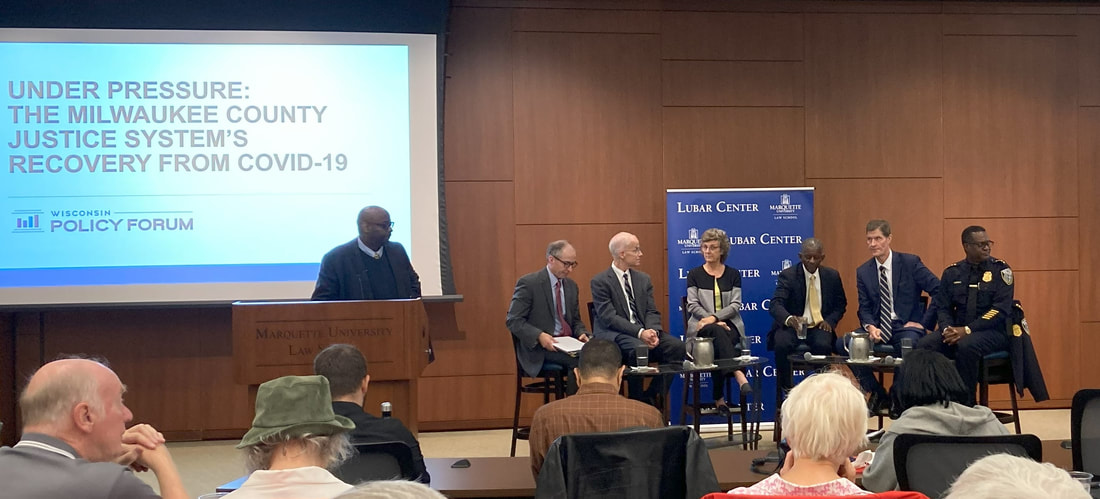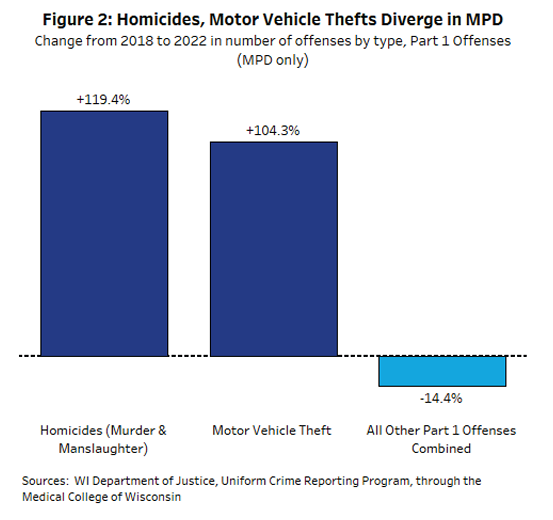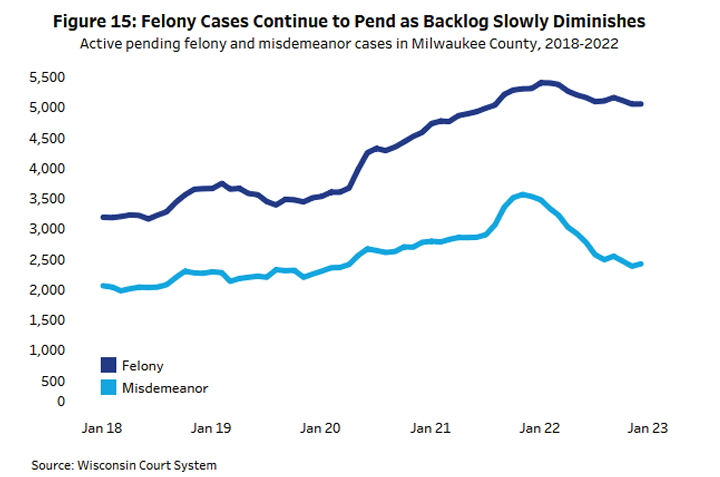|
By Margo Kirchner Milwaukee County’s criminal justice system has not fully recovered from pandemic pressures, and some data results from a recent study of the county’s justice system are not easily explained, say a researcher and five local justice-system leaders. The pandemic showed how the county’s criminal justice system is an ecosystem, with changes in one area impacting other areas, several said. However, the leaders of multiple sectors of the county’s criminal justice system continue to work together to get the system back to its pre-pandemic functioning, or better, they said. Milwaukee Police Department Chief Jeffrey Norman; District Attorney John Chisholm; Tom Reed of the State Public Defender’s Office; and the current and former chief judges of Milwaukee County Circuit Court, Carl Ashley and Mary Triggiano, spoke at a Marquette University Law School Lubar Center event last week. They were joined by Wisconsin Policy Forum President Rob Henken. The speakers discussed an August 2023 Wisconsin Policy Forum report analyzing data from 2018 through 2022. The talk was moderated by Lubar Center Director Derek Mosley. Henken started with discussion of his report “Under Pressure: The Milwaukee County Justice System’s Recovery from COVID-19,” highlighting the following quantitative findings:
Henken said the causes of these results could not be pinpointed. However, his research suggested that total offenses may have increased because police were addressing during the pandemic mainly priority calls rather than conducting proactive policing activities. In addition, the number of MPD sworn officers decreased 17% (more than 300 officers) from 2018 through 2022, which may have caused the decrease in arrests, he said. Staffing declines at the district attorney’s office may have resulted in fewer charges, he said. Henken suggested that the system’s recovery from the pandemic is now impeded by workforce challenges. Norman agreed that there is “still a lot we don’t know on why we’re where we’re at.” As explanation for some of the policing data results, such as the reduced arrest numbers, he pointed to problems during the pandemic with insufficient housing for arrestees, which meant that those accused of violent felonies were held while others were released. He also noted the shifting priorities and measures from the administrations of his predecessors. While one prior chief focused on quantitative measurements of policing such as the numbers of arrests, subsequent chiefs transitioned to qualitative measurements. “Policing is an always evolving activity,” he said. Chisholm noted how the criminal justice became a funnel for societal problems — and how that funnel has been overflowing. What is happening in the community affects what is happening in the criminal justice system, too; things are connected, he said. As an example, shutting down schools during the pandemic may have related to young people stealing cars; shutting down resources for victims of domestic violence may have led to more domestic violence issues, he said. He noted that he would like to get back to “the crappy place we were in 2019,” but said there is no finger pointing between the speakers about problems such as high homicide rates — “we all share this.” Reed said the pandemic caused a problematic reduction in the number of SPD attorneys and private bar attorneys willing to take cases when the SPD has a conflict or heavy workload. Court proceedings were put on hold until an attorney could be appointed, frustrating clients, he said. Reed said that 85% of people charged with crimes qualify for appointed counsel due to poverty. Before the pandemic, the ages of SPD attorneys and private-bar defense attorneys “skewed older,” and when the pandemic hit many older attorneys chose to retire, Reed said. One reason for retirement early in the pandemic may have been that before vaccines, older attorneys were reluctant to visit clients in jails and prisons, where COVID-19 was spreading easily. The Legislature’s increase in SPD pay stabilized his staff, and the increased private bar rate (both are features of the recent state budget) helps, Reed said. His office is down to about 100 cases needing attorneys. Former Milwaukee County Chief Judge Triggiano described the leadership group she pulled together even before the nationwide COVID-19 closures in early 2020. The court initially kept employees and litigants at home but worked around the clock to bring jury trials back while keeping participants safe. Jury trials resumed in the summer of 2020. Current Milwaukee County Chief Judge Carl Ashley, who was part of that leadership group, said Triggiano’s inclusion of system representatives such as those from the DA’s office and SPD may have been unusual, but the group discussed what the system participants could do differently to handle pandemic concerns. Ashley is continuing such meetings to keep discussing how the court and system participants can operate differently to improve. He is proud of the relationships he has with the other system partners. The court has about 5,000 pending felony cases, 1,500 of which are backlog, he said. Ashley noted that “we are not going to prison our way out” of safety issues. When asked by Mosley what he needed for the MPD going forward, Norman said “more trust, from everyone,” but he acknowledged that his department needed to earn that trust. When asked by an audience member whether the elimination of the city residency requirement for MPD officers reduced that trust, Norman said that when an officer responds it should not matter where that officer lives. His officers are expected to provide their services and if they fail to, or do it with disrespect, city residents should report it to the department, he said. Reed said that he would like more honor and acknowledgment of the work by the people at the MPD, DA’s office, SPD, and court who perform their work as a calling. Even when mistakes are made, people should “know that it’s still a noble profession.” The Wisconsin Policy Forum report found that a 2021 spike in serious offenses appeared driven by motor vehicle thefts. And while homicides and motor vehicle thefts in the City of Milwaukee increased significantly between 2018 and 2022, all other serious offenses (such as larceny theft, burglary, robbery, and rape) combined dropped. Homicides in the City of Milwaukee increased from 100 in 2018 to 214 in 2022. Motor vehicle thefts in the city spiked from 4,528 in 2020 to 12,344 in 2021, then declined to 9,447 in 2022, though correction of an MPD technical error in reporting may reduce those numbers slightly, according to the report. The report also described the continuing backlog of felony cases. In March 2023 the number of felony cases in Milwaukee County Circuit Court stood at 5,032, compared with 3,512 cases at the end of December 2019. The number of pending felony cases peaked in January 2022 at 5,405. For a year or two prior to the pandemic, the median age of a felony case in the court ranged between 150 to 200 days. The median age peaked in August 2022 at 331 and at the end of December 2022 was still high at 289 days, according to the report.
0 Comments
Your comment will be posted after it is approved.
Leave a Reply. |
Donate
Help WJI advocate for justice in Wisconsin
|
Copyright © 2024 Wisconsin Justice Initiative Inc.
The Wisconsin Justice Initiative Inc. does not endorse candidates for political office. The Wisconsin Justice Initiative Inc. is a 501(c)3 organization.
The Wisconsin Justice Initiative Inc. does not endorse candidates for political office. The Wisconsin Justice Initiative Inc. is a 501(c)3 organization.




 RSS Feed
RSS Feed